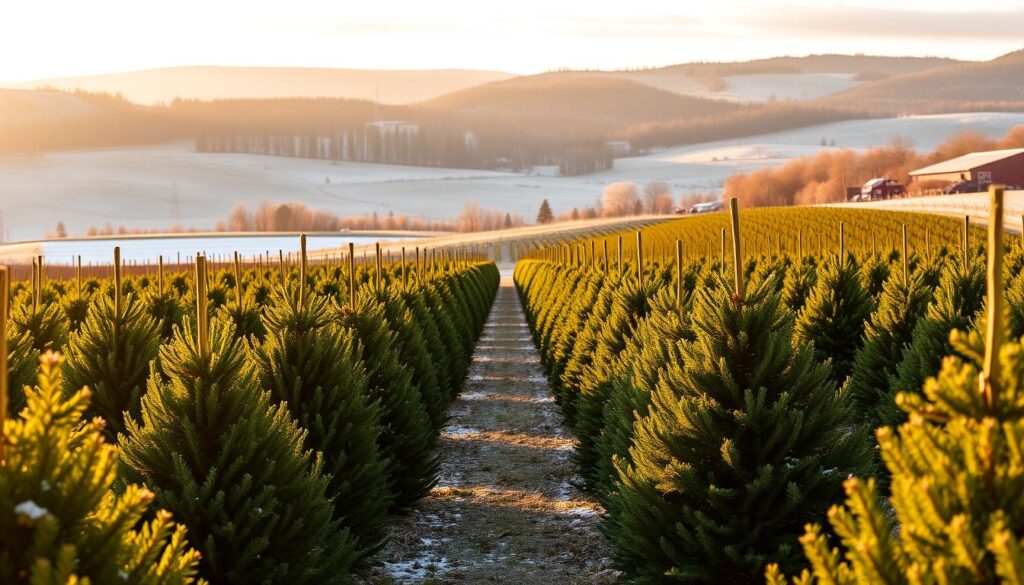As the holiday season comes near, the debate between artificial and real Christmas trees heats up again. Both have their good points and downsides, making it hard to decide which is better. In the U.S., about 10 million artificial trees are bought each year. On the other hand, around 30 million real trees are cut down annually from 350-500 million on tree farms.
This choice affects the environment, your wallet, and your home. It’s important to think about these factors carefully.
Key Takeaways
- Real Christmas trees help fight climate change by absorbing carbon and supporting sustainable forest management.
- Artificial trees have a much higher carbon footprint, as nearly 90% are imported from China.
- Real trees can be recycled and repurposed, unlike artificial trees that often end up in landfills.
- Purchasing a real tree supports local tree farmers and ensures the maintenance of healthy forests.
- Artificial trees may be more cost-effective in the long run, but real trees provide a more environmentally friendly option.
Understanding the Christmas Tree Tradition and Modern Choices
The tradition of decorating homes with Christmas trees comes from northern Europe, dating back centuries. Today, over 100 million U.S. homes display these festive trees. Real trees offer a fragrant charm, while artificial ones provide convenience and last longer.
Evolution of Christmas Tree Customs
The modern Christmas tree tradition started in 16th-century Germany. Evergreen trees were decorated with candles and ornaments. This tradition spread to Europe and North America. In the U.S., 25-30 million real trees are sold each year, mostly from Oregon and Washington.
Current Market Trends in Tree Selection
Artificial trees are now popular, with 80% made in China. They last 5-10 years, making them a favorite for many. PVC trees are affordable, but polyethylene (PE) trees, which look more real, are becoming more popular, though they cost more.
The Shift from Traditional to Modern Options
The Christmas tree market has grown to meet different tastes. Now, there are fiber optic, flocked, tinsel, and pre-lit trees. Whether you choose a real tree or an artificial one, the holiday spirit stays the same.
“An artificial Christmas tree can last up to ten years, making it the more eco-friendly option if used for a minimum of five years.”
Environmental Impact Comparison
The debate between artificial and real Christmas trees often centers around their environmental impact. Both options have their pros and cons. It’s important to understand these nuances to make a sustainable choice.
Real Christmas trees act as carbon sinks, absorbing CO2 as they grow. In fact, an average real tree can absorb up to 2 tonnes of CO2 and provide enough daily oxygen for 44 people. However, how they are disposed of can affect their environmental footprint. Landfilling retains the carbon, but can cause other issues, while composting is a better option.
Artificial trees, on the other hand, have a higher carbon output during production. The manufacturing process results in about 88 pounds of carbon dioxide emissions, which is 10 times higher than sustainably grown real trees. But, if an artificial tree is used for 5-10 years, it can have a lower global impact than annually replacing real trees.
| Environmental Factor | Artificial Tree | Real Tree |
|---|---|---|
| Carbon Footprint | 48.3 kg CO₂ (for a 2-meter tall tree used for 6 years) | 3.1 kg CO₂ per year |
| Sustainability | Reusable for 5-10 years, but high initial emissions | Renewable and recyclable, but requires annual replacement |
| Habitat Benefits | Minimal impact on wildlife | Tree farms provide habitat for various species, especially early-successional birds |
The environmental impact of Christmas trees depends on several factors. These include disposal methods, transportation, and how long the tree is used. By considering sustainability, allergy and health considerations, and fire safety, consumers can make an informed choice. This choice should align with their values and ecological concerns.
Cost Analysis: Long-term Investment vs. Annual Purchase
Choosing between artificial and real Christmas trees often comes down to cost. Artificial trees might cost more upfront but save money in the long run. Real trees, on the other hand, need to be bought every year and come with extra costs for care and disposal.
Initial Purchase Considerations
Artificial Christmas trees can cost between $50 and $500 or more. This is based on size, features, and brand. Even though they’re pricey at first, they can be used for many years, saving money over time. Real trees, priced between $50 and $180, are getting pricier, with a 5-15% hike expected this year.
Maintenance and Additional Costs
Real trees need regular watering, trimming, and disposal. These costs can add up, especially for bigger trees. Artificial trees, however, need little care, just a dusting or storage between uses.
Long-term Financial Impact
As real tree prices rise, artificial trees become more cost-effective over several years. An artificial tree used for five years uses 1.5 times fewer resources than a real one. Using the same artificial tree for ten years makes it three times less wasteful than a real tree.

“The Artificial Christmas Trees Market is expected to show an unexpected Compound Annual Growth Rate (CAGR) from 2023 to 2030 compared to data from 2016 to 2022.”
When deciding between artificial and real trees, think about more than just the initial cost. Consider the long-term financial and environmental effects. For a cost-effective and eco-friendly holiday decor, artificial trees might be the better choice.
Artificial vs. Real Christmas Trees: Which is Better for You?
Choosing the perfect Christmas tree is a big decision. You have to decide between artificial and real trees. Let’s look at the good and bad of each to help you choose.
If you love tradition and making memories, a real tree might be best. A 2019 survey found that real tree buyers value holiday traditions more. Plus, real trees are cheaper, costing $78 on average compared to $104 for artificial ones.
Real trees are also better for the environment. They have a smaller carbon footprint than artificial trees. Real trees can be recycled and biodegradable, while artificial ones often end up in landfills.
But, if you want something easy and don’t have much space, an artificial tree might be better. Artificial trees can last for years, reducing environmental harm. They also save you from the trouble of getting rid of a tree every year.
| Consideration | Artificial Tree | Real Tree |
|---|---|---|
| Tradition and Memories | Less likely to value holiday traditions | More likely to value holiday traditions |
| Environmental Impact | Three times the impact on climate change and resource depletion | Smaller carbon footprint, completely biodegradable and recyclable |
| Convenience and Space | Reusable for several years, no annual disposal | Annual purchase and disposal required |
| Cost | Average price of $104 | Average price of $78 |
Choosing between an artificial or real Christmas tree depends on what matters most to you. Whether it’s tradition, the environment, convenience, or cost, there’s a tree that fits your needs.
Sustainability and Carbon Footprint Analysis
Christmas trees have an environmental impact, whether they’re real or artificial. It’s important to know how each option affects the planet. This knowledge helps you choose what’s best for you and the environment.
Tree Farm Benefits and Ecosystem Impact
Real Christmas trees grown on farms can help the environment. They absorb CO2 and release oxygen. These farms also support wildlife, helping local ecosystems thrive.
Tree farms protect green spaces and prevent habitat loss. This is especially important in developing areas.
Manufacturing and Transportation Effects
Artificial trees, on the other hand, have a big environmental cost. Making them uses a lot of energy and emits greenhouse gases. The materials, like PVC, are not good for the planet.
Disposal Methods and Environmental Consequences
How you dispose of a tree matters. Real trees can be composted or used in creative ways. But, if they go to the landfill, their impact grows.
Artificial trees can be more eco-friendly if used for many years. Proper disposal or donation is key.
Choosing between real and artificial trees is a big decision. It depends on your values and what’s best for the planet. Knowing the facts helps you make a choice that’s good for everyone.

| Metric | Real Christmas Tree | Artificial Christmas Tree |
|---|---|---|
| Carbon Footprint (Disposal via Wood Chipper/Bonfire) | 3.5 kg CO2 | 40 kg CO2 (if discarded after 2 m height) |
| Carbon Footprint (Landfill Disposal) | 16 kg CO2 | 40 kg CO2 (if discarded after 2 m height) |
| Annual Sales in the U.S. | 25-30 million | N/A (Majority of households opt for artificial trees) |
| Cultivation Time | 12 years | N/A (Manufactured) |
“Christmas tree farms can offer diverse habitats, contributing to a higher biodiversity compared to adjacent grasslands or forests.”
Convenience and Maintenance Factors
Choosing between an artificial or real Christmas tree involves thinking about convenience and maintenance. Artificial trees are easy to set up and come pre-lit, saving you from decorating hassle. Real trees, however, need regular watering and cleaning to manage needle shedding, which takes more time.
Artificial trees are great because you can use them year after year. This means you don’t have to buy a new tree every year. Plus, they’re safer to decorate because they don’t have needles or sap.
But, real Christmas trees offer a unique, traditional experience. Choosing and bringing home a fresh tree is a special family tradition. It brings joy and a connection to nature. Plus, real trees are better for the environment because they can be recycled after the holidays.
In the end, whether to choose an artificial or real tree depends on what you value more: tradition or convenience. Both have their good points, and the right choice depends on your personal preferences and values.

| Feature | Artificial Tree | Real Tree |
|---|---|---|
| Assembly | Easy, with pre-lit options | Requires annual setup and placement |
| Maintenance | Minimal, only requiring occasional dusting | Regular watering and needle cleanup |
| Display Period | Can be used for multiple years | Limited to the holiday season |
| Decorating | Easier, no risk of needle pricks or sap | Potential for needle pricks and sap |
Health and Safety Considerations
Choosing between artificial and real Christmas trees involves health and safety factors. Both have benefits and risks. Knowing these can help make your holiday season safer and more enjoyable.
Allergy and Respiratory Concerns
Real Christmas trees can cause allergies. Pollen, mold, and dust on the needles and branches can lead to sneezing and itchy eyes. Artificial trees, however, are better for those with allergies or asthma.
Fire Safety and Prevention
Dried real Christmas trees are a fire hazard. The National Fire Protection Association reports that Christmas trees cause 160 house fires a year. These fires result in three deaths, 15 injuries, and $10 million in damage. Keeping the tree watered and checking for dryness is key. Artificial trees, treated with flame-retardant chemicals, are safer.
Child and Pet Safety
Both real and artificial trees can be dangerous for kids and pets. Sharp needles, loose ornaments, and electrical cords are hazards. Make sure the tree is stable, decorations are secure, and pets and children can’t get too close.

Considering health and safety can help you choose the right Christmas tree. Focus on eco-friendliness, sustainability, and safety for a worry-free holiday.
Storage and Longevity Comparison
Choosing between artificial and real Christmas trees involves considering longevity and storage. Artificial trees last longer, up to 10 years or more with proper care. Real trees, however, are usually thrown away each year, making them a quicker choice.
Storage is a big difference. Artificial trees need a place to stay when not in use. Real trees can be reused or recycled, which is better for those with little space.
| Comparison Factor | Artificial Tree | Real Tree |
|---|---|---|
| Average Lifespan | 5-10 years or more | 1 season |
| Storage Requirements | Requires dedicated off-season storage space | Can be repurposed or recycled after use |
| Environmental Impact | Higher carbon footprint, but can be reused for many years | Lower carbon footprint, but is a renewable resource |
When looking at storage and longevity, think about what you need and want. Consider your space and the planet’s health. Both artificial and real trees have good points, depending on your life and values.
“The average American car emits about 1.5 tons or 3000 pounds of carbon into the atmosphere on a yearly basis, for comparison purposes.”
Real trees are better for the environment because they’re renewable. But, artificial trees can last a long time, making their initial impact less bad. Your choice should match your lifestyle and what you care about most.
Conclusion
Choosing between artificial and real Christmas trees depends on what matters most to you. Both have good and bad sides, from how they affect the environment to their cost and ease of use.
Real Christmas trees win when it comes to being eco-friendly. They can be recycled, composted, or reused after the holidays. Artificial trees, made mostly from plastic, often end up in landfills. Yet, they can be used for many years, which might make up for their initial environmental harm.
Looking at renewable resources, real trees are a better choice. They grow on farms and help the environment while they’re alive. Artificial trees, however, are made from petroleum products, which harm the environment more.
FAQ
What is the environmental impact of artificial versus real Christmas trees?
Real trees absorb CO2, acting as carbon sinks. Artificial trees, however, have a higher carbon footprint due to their production and transport. Yet, if used for 5-10 years, artificial trees can be more eco-friendly.
The way we dispose of these trees also matters. Composting is better than burning or landfilling for real trees.
Which option is more cost-effective in the long run?
Artificial trees are pricier upfront but can be reused for years. This makes them more cost-effective over time, especially if used for 5-10 years. Real trees need to be bought every year and come with extra costs for care and disposal.
However, as real tree prices rise, artificial trees become a more affordable choice in the long run.
What are the convenience factors to consider when choosing between artificial and real Christmas trees?
Artificial trees are easy to set up and come with pre-lit options. They also need little maintenance. Real trees, on the other hand, require regular watering and need to be replaced every year.
But, real trees offer the joy of picking a fresh tree each year.
How do artificial and real Christmas trees differ in terms of health and safety considerations?
Real trees can cause allergies and asthma. Artificial trees are better for those with allergies and are flame-retardant. However, dry real tree needles can be a fire hazard.
Both types need safety precautions, especially with lights and decorations. It’s also important to think about child and pet safety.
How do the storage and longevity of artificial and real Christmas trees compare?
Artificial trees can last 5-10 years or more with proper storage. Real trees, however, are thrown away every year. Artificial trees take up space when not in use, while real trees can be recycled or repurposed.
What are the key factors to consider when choosing between artificial and real Christmas trees?
The decision between artificial and real trees depends on what matters most to you. Consider the environmental impact, cost, convenience, tradition, and your personal preferences. Both have their advantages and disadvantages.
Think about how long you plan to use the tree, how you’ll dispose of it, and the environmental impact. This will help you make the best choice for you.






